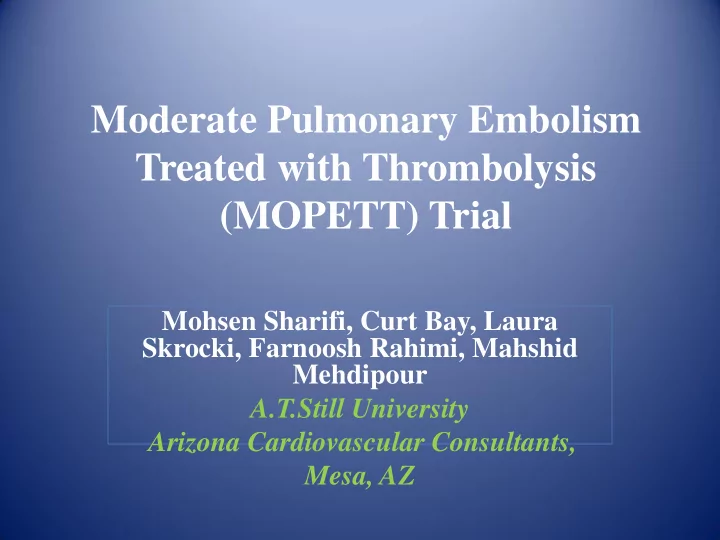

Moderate Pulmonary Embolism Treated with Thrombolysis (MOPETT) Trial Mohsen Sharifi, Curt Bay, Laura Skrocki, Farnoosh Rahimi, Mahshid Mehdipour A.T.Still University Arizona Cardiovascular Consultants, Mesa, AZ
Disclosures • MS: Consultant to Covidien
Pulmonary Embolism • >100,000 annual deaths • Third leading cause of cardiovascular mortality • Most common preventable cause of death
• Thrombolysis has been used for massive PE • Hemodynamic instability and shock • 5% of PEs qualify for standard dose • Concern about major bleeding and ICH • ICH 2-6% • Major bleeding 6-20%
• Standard dose t-PA 100mg in 2 hrs • Hesitancy of practitioners to use t-PA when patient is hemodynamically stable • Unresolved issue of concomitant parenteral anticoagulation with t-PA
• “SAFE DOSE t- PA” ?
“ SAFER DOSE t- PA” ?
Rationale for Efficacy of “ Safe dose” thrombolysis • Thromboembolus in pulmonary arterial circulation is exquisitely sensitive to lysis • Lungs= point of convergence of venous circulation • Pulmonary blood flow= Entire CO • Almost all t-PA molecules converge in lungs • Different than in thromboembolic CVA and acute MI • Brain 15% of CO; Heart 5%; hence same dose should not necessarily apply
MOPETT Trial 121 Patients TT= CG= 61 60 56 58 F/U= 28±5 m
Primary Endpoints 1) Pulmonary HTN 2) Recurrent PE+ Pulmonary HTN
Secondary Endpoints • In-Hospital Bleeding • Duration of Hospitalization
Inclusion criteria • PE + 2 of the following: – Chest Pain – Tachypnea > 22 RPM – Tachycardia resting HR>90 BPM – Dyspnea – JVP > 12 cmH20 – Cough – Oxygen desaturation
Evaluation of Troponin I and BNP Echocardiographic features – PASP> 40 mmHg – RV hypokinesia – RV enlargement
Exclusion Criteria • BP≥200/100 • Surgery , major trauma in preceding 2 weeks • Brain mass • ICH, SDH , neurologic surgery within preceding 1 year • GI bleeding requiring transfusion in preceding 2 m • Need for full dose thrombolysis
“Safe Dose” t -PA • For ≥ 50Kg = 10mg in 1 min followed by 40 mg in 2 hr • For < 50 Kg = 0.5mg/Kg total dose : 10 mg in 1 min followed by remainder in 2 hr
FG CG p Value n= 61 N=60 Male 28 (46) 27(45) 0.92 Age 58±9 59±10 0.56 Weight 84±14 83±13 0.68 Previous or concomitant disease- n (%) Hypertension 32 (52) 31 (52) 0.93 Diabetes mellitus 23 (38) 25 (40) 0.66 Cardiovascular 35 (57) 37 (62) 0.80 Hypercholesterolemia 27 (33) 25 (30) 0.77 Pulmonary 22 (36) 25 (42) 0.53 Renal 8 (13) 9 (15) 0.77 Current smoker 12 (20) 15 (25) 0.48 Unprovoked PE 28 (46) 27 (45) 0.92 Estrogen therapy 6 (10) 7 (12) 0.75 Cancer Active 8 (13) 9 (15) 0.77 History 3 (5) 3 (5) 0.98 Known prothrombotic state 6 (10) 5 (8) 0.77 Previous VTE 13 (21) 12 (20) 0.86 Concomitant DVT 35 (57) 33 (55) 0.79
Concomitant Anticoagulation TG • Enoxaparin ( 80%) : 1mg/Kg/SQ ( not to exceed 80 mg for initial dose) • Heparin (20%) Bolus = 70 U /Kg, and not to exceed 6000U Maintenance 10 U/Kg/ Hr while tPA being infused ( not to exceed 1000U/Hr) 1 hr after termination of t-PA increased to 18 U/Kg/Hr Adjusted to PTT 1.5-2 X baseline
Intense fluctuations in PTT with “standard heparin protocols” 200 150 100 50 0 6 hr 23 hr 9 hr 6 hr 12 hr
Anticoagulation CG • Enoxaparin ( 80%) : 1mg/Kg/SQ BID • Heparin (20%) Bolus = 80 U /Kg followed by 18 U/Kg/Hr • Warfarin started on admission
• 66% had BNP or Trop I elevation • RV enlargement 12/61(20%) and 14/60 (23%) • RV hypokinesia 3/61(4.9%) and 4/60(6.6%)
TG CG p Value Initial PASPmm Hg 50±6 51±7 0.40 - 16 ± 3 -5 ± 2 Change within 48 hours <0.001 PASP at 6 m 31±6 49±8 <0.001 PASP at final F/U 28±5 43±6 <0.001
Primary Endpoints TG N= CG N=56 p Value 58 Pulmonary HTN at 28 m 9 (16) 32 (57) p<0.001 9 (16) 35 (63) p<0.001 Pulmonary HTN + recurrent PE at 28 m Pulmonary HTN= PASP> 40 mmHg
Secondary Endpoints TG N= 61 CG N=60 p Value Recurrent PE 0 3 (5) 0.077 Mortality 1(1.6) 3 (5) 0.301 PE + Mortality 1 (1.6) 6 (10) 0.0489 Hospital Stay 2.2±0.5 4.9±0.8 <0.001 In-hospital Bleeding 0 0 -
Thrombolysis serving as a “pulmonary stress test” • Patients with infarction would develop worsening or new onset chest pain • Ambulatory within 24 hr
Changes in PASP ( mmHg ) 60 50 40 30 Thrombolysis 20 Control 10 0 On Within 48 6 months 28 admission Hr months
Eligibility For Thrombolysis Safe dose eligible High dose eligible No need for thrombolysis Contraindications to thrombolysis
Conclusions • Low dose thrombolysis is safe and effective in moderate PE • Rapid reduction in PA pressures • Reduction of Pul HTN & recurrent PE at 28 m • No bleeding/ ICH • Earlier hospital Discharge : ( pulmonary “stress test”) • Trend in reduction of recurrent PE and possibly mortality • Importance of dose modification for concomitant anticoagulants
HAPPY NOWRUZ
Recommend
More recommend